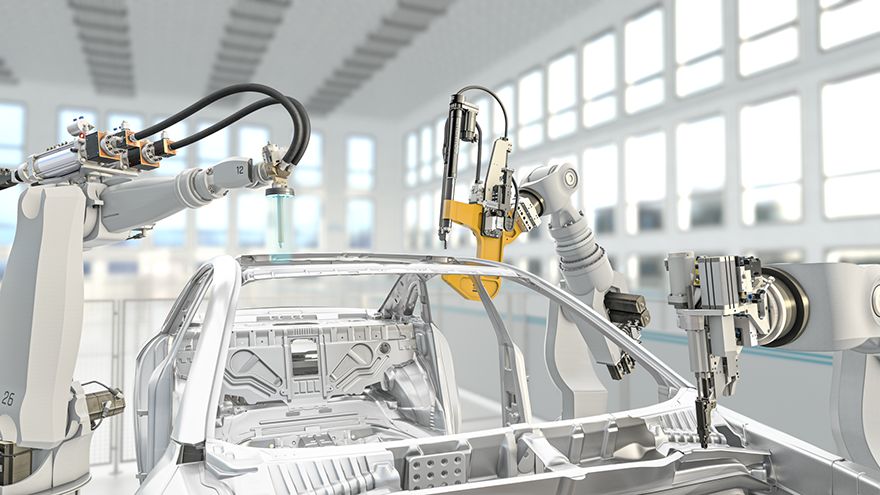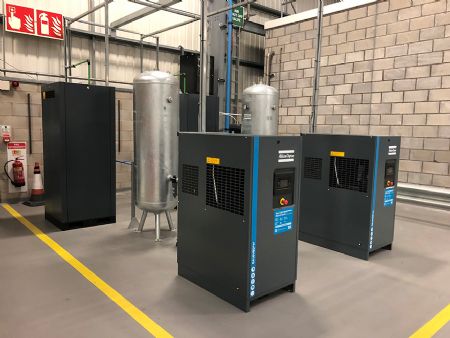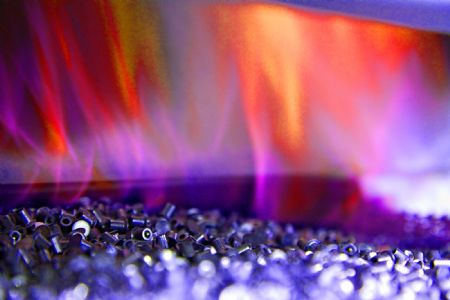
To meet growing demand from vehicle builders for its specialised self-piercing rivets and tools — and to ensure 24/7 continuity of output from its Deeside production plant —
Atlas Copco Industrial Assembly Solutions (ACIAS) has installed an on-site nitrogen generation system that feeds its heat treatment hardening process operation and overcomes dependence on vendor-delivered supply of the gas.
As automotive assembly applications become more complex, with new hard-to-join materials, and others that cannot be welded, self-piercing rivets and tooling provides the answer. With its annual output in the order of one billion items, it is essential for ACIAS (formerly known as Henrob) to maintain the integrity and continuous performance of its rivet hardening furnaces, which are critical to end-product quality. The reliable supply of nitrogen, and its purity level, plays a vital part in the process.
Until recently, liquid nitrogen was supplied in bulk to site from the vendor, then vaporised for delivery to the production heat treatment furnaces. The purity level of the delivered nitrogen was 99.999%, but calculations proved that if the nitrogen supply could be set at 99.8% purity, it would reduce the running cost of a very high purity gas which was not necessary for the process.
It was this anomaly, among other factors, that convinced the production management team to opt for an on-site nitrogen generation system to be supplied by the company’s sister organisation, Atlas Copco Compressors.
On-site NGP+ generators provide nitrogen between 95-99.999% purity. They offer a more sustainable and much lower cost of ownership solution than reliance on gas delivered in cylinders or bulk liquid supply. Nitrogen gas is continuously available from an NGP+ whereas cylinders and bottles require transport and handling, which impacts on the environment, as well as time-consuming administration and paperwork.
Operating with the latest pressure swing adsorption (PSA) technology, the NGP+ plug-and-play generators, when connected to an existing clean, dry compressed air installation, offer an independent, dependable, and flexible supply of premium grade nitrogen at the process application’s required purity levels.

Carlo Sementa, manufacturing engineer at Atlas Copco IAS UK Ltd, said: “The heat treatment of the rivets changes the material’s mechanical properties. We have to control the atmosphere of the furnaces for carbon content to make sure we do not either de-carb or carburise the parts.
“We have ‘state of the art’ control system alongside gas analysers, which are used for verification of atmosphere chemical composition. The nitrogen is used as a blanket to prevent oxidation of the steel parts and as a safety purge.”
In the heat treatment process, the procedure is to crack liquid methanol and, with the addition of nitrogen, deliver a consistent chemical composition to the furnace. Propane and air are also used in the process to fine tune the chemical composition that is needed to maintain the carbon content of the steel.
Nitrogen is being supplied to the furnace 24/7 in varied quantities dependant on requirements, for example, production or standby. At the end of a production cycle, the furnaces are purged with nitrogen to remove the combustible gases. After this procedure, it can take up to eight hours before a production run can start again due to recreation of atmosphere, an interval that differs slightly from furnace to furnace.
This need for precise control of the nitrogen volume and purity level is one of the major benefits of the Atlas Copco NGP+ nitrogen generator system, which has been designed from the outset to protect the process application and the users’ equipment investment.
By default, NGP+ generators feature an automatic off-spec check purity control so that nitrogen with a purity level less than the pre-set threshold can never reach a sensitive application. At the same time, feed air conditions such as temperature, pressure and pressure dewpoint are continuously monitored by fail-safe sensors. When not matching the generator requirements, the feed air is blown off automatically before entering the machine to eliminate the risk of contamination and damage to components.

The source of clean dry compressed air feeding the on-site nitrogen generation process at the Deeside plant is an Atlas Copco GA 15-37 VSD+ FF (full feature) rotary screw compressor with integrated refrigerant dryer and quality air ancillaries downstream. These include coalescing filters, to remove liquid water and oil aerosols plus an active carbon filter tower to deal with oil vapours and hydrocarbon odours. Output from the rotary screw compressor is at the rate of 7.3-43l/s of 7-bar air.
With its innovative vertical design, the GA 15-37 VSD+ is a ‘game changer’ in the compressor industry. It offers Variable Speed Drive as standard, a compact, direct drive, oil-cooled iPM (permanent magnet) technology motor, and a small footprint thanks to its in-house design. All features have been developed to reduce energy consumption by an average 50% and to assure uptime even in the harshest conditions.
The whole on-site nitrogen generation system has been designed with duty standby so that from a safety and servicing perspective it can easily be switched over from running both units to a single machine when needed. There are two receiver tanks for air and nitrogen respectively as a secondary backup in case the system should stop working for any reason, and, for additional safety, there is a restart system.
Mr Sementa added: “We are pleased to report that currently it is all running very nicely 24/7 and, although production cycles vary in frequency and duration, as a precaution we have to keep the furnaces’ atmosphere fully on at all times because of the extensive stabilisation time cycle. The really good news is that I am not at the mercy of suppliers and relying on vendor deliveries of nitrogen any more.”
ACIAS production costs have already been reduced as a consequence of the energy efficiency of the installation and by the freedom from dependence on costly deliveries of over-spec nitrogen supplies. Additionally, the return on capital investment will see a payback completed within one-and-a-half years from the system’s installation.